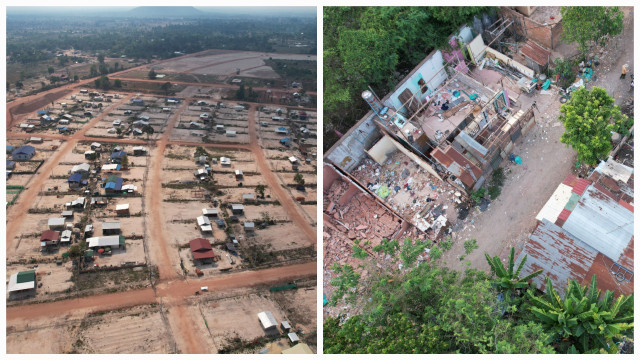Angkor Relocations: Why Rights Groups Get it Wrong

- By Alan Kirk
- July 9, 2023 10:00 AM
SIEM REAP – By any standard, Sot Kong’s living standards were appalling. Her family’s slum dwelling, built illegally near Angkor Wat, had no clean water. Children played near sewage which drained into the ground around the nearby shacks.

All that changed when her family were among many who were moved 40 kilometers to Run Ta Ek village to housing provided by the government.
However, the relocation has been harshly criticised by human rights organisations though strongly defended by officials responsible for implementing the scheme.

In March, Amnesty International accused the government of mass forced deportations and called on authorities to stop what it called a violation of human rights.
“People were pressured to volunteer and made to feel fearful of reprisals if they refused to leave or challenged the evictions,” said Ming Yu Hah, Amnesty’s deputy regional director for campaigns.
“The Cambodian authorities should immediately halt this harmful eviction drive that seriously risks impoverishing thousands of families.”
However, authorities responsible for moving hundreds, maybe thousands, of people from the world heritage Angkor Archaeological Park defend the rehousing of families squatting on state land even if there was some reluctance to move.
“There are no human rights issues,” says Long Kosal, deputy director-general of the APSARA National Authority which is responsible for the Angkor site.

“While they are doing things illegally, they cannot do it properly,” he said. “Their house is not a house. It is a hut. They do not have a proper toilet. Sanitation is zero. There is no clean water.”
Some had paid for land from people who were not entitled to sell, with transactions signed off by village chiefs ignorant of the law. Long Kosal declines to speculate on any financial gain for the local officials.
“The land that they said that they bought is illegal. They have no land title, no rights to build a house, no rights to occupy there or to live there.
“The living conditions are very poor, exposing themselves to danger. So many health issues are there, so that’s the problem.

“We are asking them to volunteer to leave the site because we care for their future. There is no future for the younger generation.
“They get a plot of land 20 meters by 30 meters. With that plot, they will have title recognised by the state. They will have a health center, a hospital, a school, clean water, a market, a pagoda.

“Everything to support a place to live is being set up by the government for them. Is that a matter of human rights or is that a matter of making their lives better?
“At their new place, the children can go to school. They have a primary school, secondary school and high school. They have also a hospital, maternity section and general health clinic.

“With the support of the government they also get an ID Poor card and that is to be supported for 10 years. While they are living in their old homes they did not have such social programs.
Long Kosal said two groups of people live in Angkor. “There are the people who have been living in Angkor for generations in 112 villages,” he said.

“The other category is the people that migrated from all over the country to occupy Angkor illegally.”
Those whose families stretched back generations were allowed to stay and renovate, but not extend, their homes. “They are the people we call the protectors of Angkor,” Long Kosal said.
“We at the APSARA Authority have an obligation to ensure a better livelihood for these people and that is why we run social programs for them.

“We build roads, bridges and schools. We also support what we call capacity-building programs for the community. We have created tourist-based communities and social programs to allow them to have substantial earnings.”
One drawback was that these programs had led to a boom, prompting people from other parts of the country to come in after 2000 and occupy or pay for land. The number of residents living illegally had kept rising.

The newcomers were being relocated, though established families could also opt to move, he said.
At the heart of the issue is the archaeological park’s status on UNESCO’s world heritage list, a status valued highly by the government for its tourism value and for the world body’s help in researching and preserving the center of the Khmer Empire.
The illegal occupations compromise the outstanding universal values of the of the 400 square kilometer park.
The APSARA Authority is keenly aware that neglecting its obligations to preserve the park’s heritage values would have serious consequences.

In 2021, the English city of Liverpool became only the third place in nearly 50 years to lose its world heritage status when UNESCO concluded that years of development had led to an irreversible loss of the historical value of its Victorian docks.
And while Liverpool shrugged off the delisting, Cambodia has a lot more to lose with tourism representing nearly 12 percent of the country’s GDP and Angkor Wat being the top attraction.
APSARA officials are also keen to keep UNESCO’S support for restoration of the Angkor Empire’s infrastructure, some of which is being damaged by the numbers of people living nearby.

An example of restoration were the ancient barays, reservoirs which were part of the irrigation systems which allowed for the expansion of the Khmer Empire.
“We can bring back to life what was built in the 9th century and make it re-emerge in the 21st century,” Long Kosal says.
_1688808829.png)
"This is very important and also shows what we call the Khmer cultures because Angkor is a series of continuations of the empire.
“The work that was done is being taken care of by the generations since the Angkorian period and to bring back to life those things is really amazing. Never before has anyone in the world in the modern day been able to do that.”
_1688807749.png)
For Sot Kong, her hopes for her new home are more modest.
“When I first came here, it was a bit hard. But over time, it became normal. It is just a bit hot here,” she said.
“I just make small business here for the sake of living and it only brings in about 20 percent of revenue when compared to my old place.
_1688807828.png)
“Over there, I could earn more but it was not my own property. We could not build anything. Here, we can build more if we have money.
“In the future, I think this place will become a small, beautiful city”.
_1688808025.png)
Additional reporting by Ky Chamna















